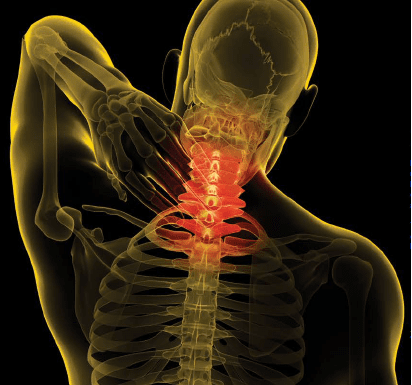After one to two weeks of the injury, Northwestern scientists found unusual muscular changes in the chronic pain group using a sophisticated MRI that measures the fat/water ratio in the muscles. The imaging revealed large amounts of fat infiltrating the patients’ neck muscles, indicating rapid atrophy.
The presence of fat in the muscle does not appear to be related to a person’s body size or shape.
“We believe this represents an injury that is more severe than what might be expected from a typical low-speed car crash,” Elliott said.
“This opens up a new door for research on whiplash.
“For a long time whiplash has been treated as a homogenous condition. Our study has shown these patients are not all the same; they have different clinical signs and symptoms.”
The finding builds on previous research Elliott did as a post-doctoral fellow at the University of Queensland, Brisbane, Australia. That study, which used standard MRI imaging, also found a large amount of fat in neck muscles of whiplash patients at one and three months post injury. Those patients went on to develop chronic pain and disability.
“These patients have shown to not respond well to traditional rehabilitation such as physical therapy,” Elliott said. “It appears that they may require a more concerted effort for pain management from their physician and help from a psychologist.”
The findings may indicate the importance of changing standard imaging protocols to identify these individuals early and start accelerated treatment. Routine imaging does not reveal this fat infiltration in individuals with whiplash injuries.
Elliott hypothesizes these patients may have partially damaged their spinal cord. They reported feeling fatigued and clumsy when walking and weakness in their legs, with difficulty pushing hard on the gas pedal of a car or standing on their tiptoes.
“We haven’t found an effective treatment for these folks with chronic whiplash, and I think it’s because we haven’t really figured out what’s wrong with them,” Elliott said.
The finding helps to demystify the condition and let individuals know their chronic pain is not all in their heads. A basic exam will not consistently show a fracture, herniated disc or ligament tear.
“If you’re a whiplash patient with ongoing chronic pain, but no objective imaging finds anything wrong, people are frequently informed that nothing is wrong with them,” Elliott said. “It’s been a huge problem.”
“That fat appears to be a response to an injury,” Elliott said. “What has actually been injured remains for us to find out. But now we know to look more deeply into the problem.”
Story Source:
The above story is based on materials provided by Northwestern University.
Journal Reference:
- James M. Elliott, D. Mark Courtney, Alfred Rademaker, Daniel Pinto, Michele M. Sterling, Todd B. Parrish. The Rapid and Progressive Degeneration of the Cervical Multifidus in Whiplash. Spine, 2015; 1 DOI:10.1097/BRS.0000000000000891
Page Citation:














Add Comment